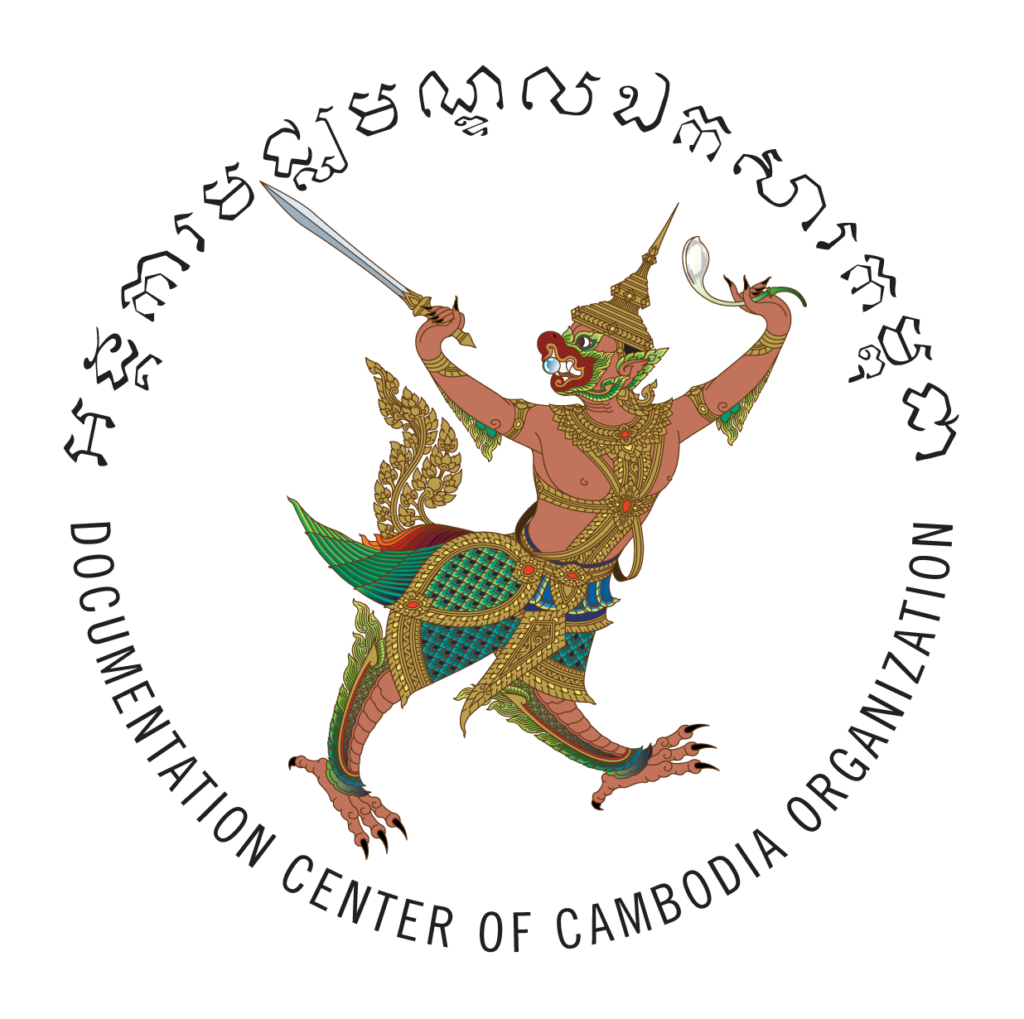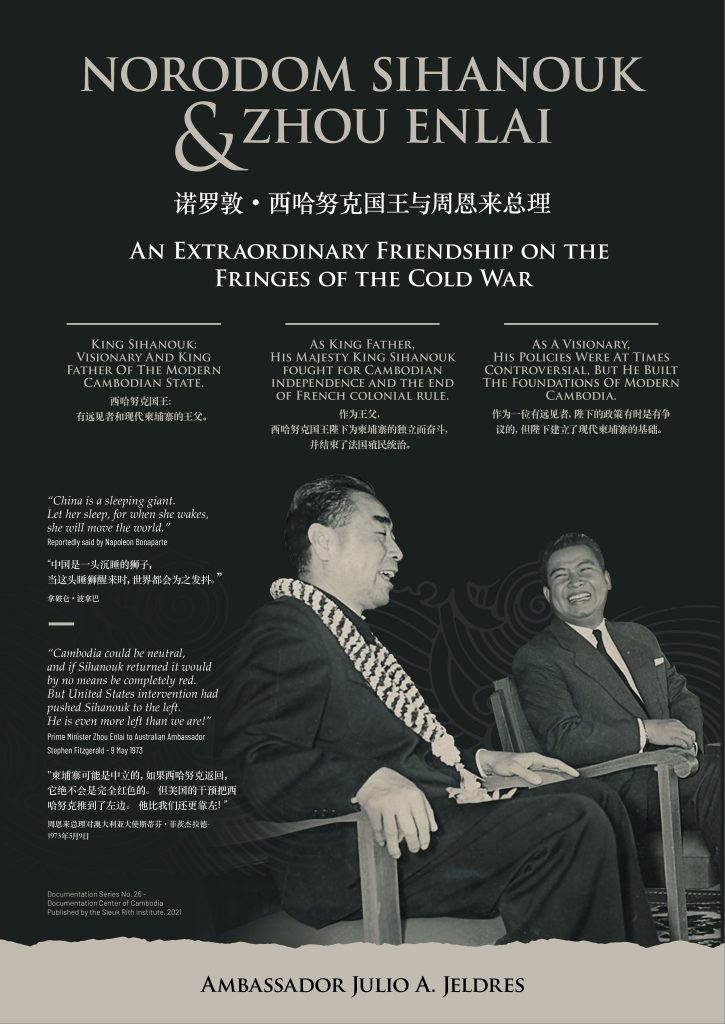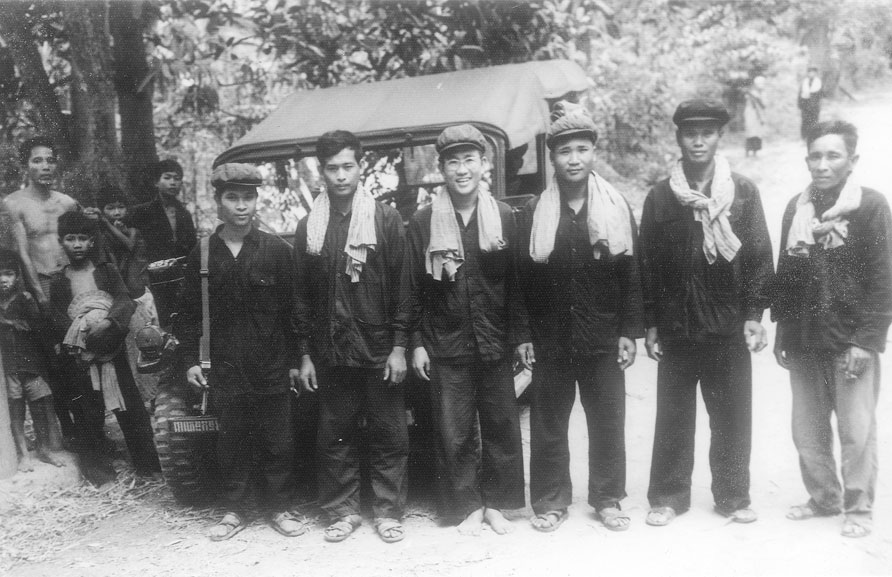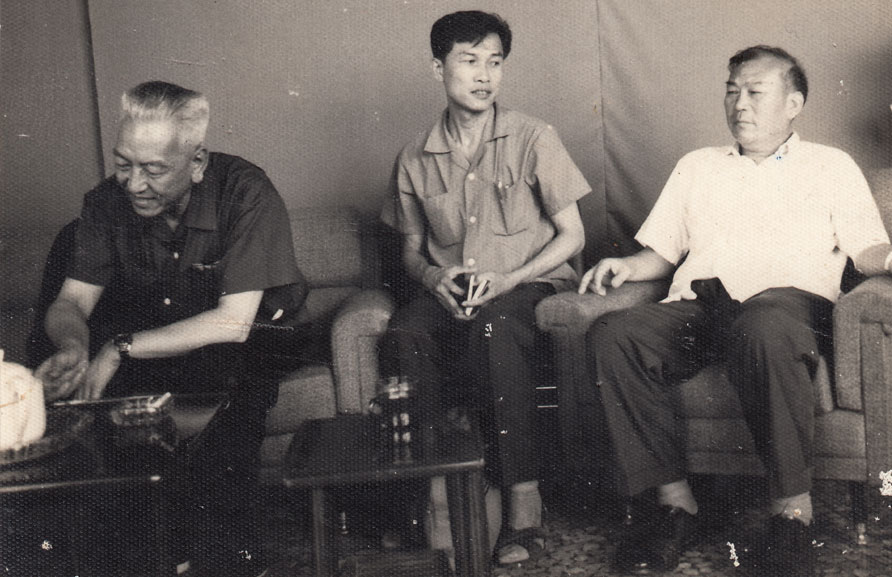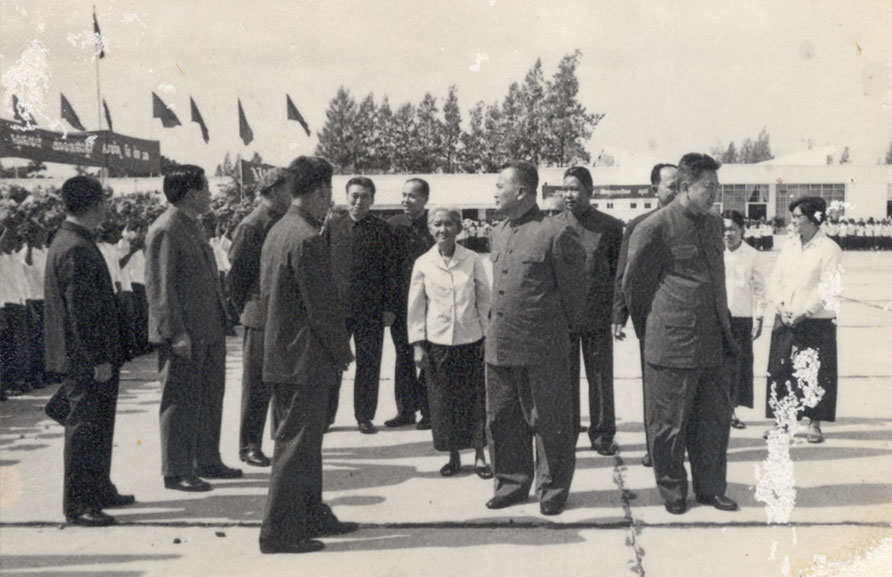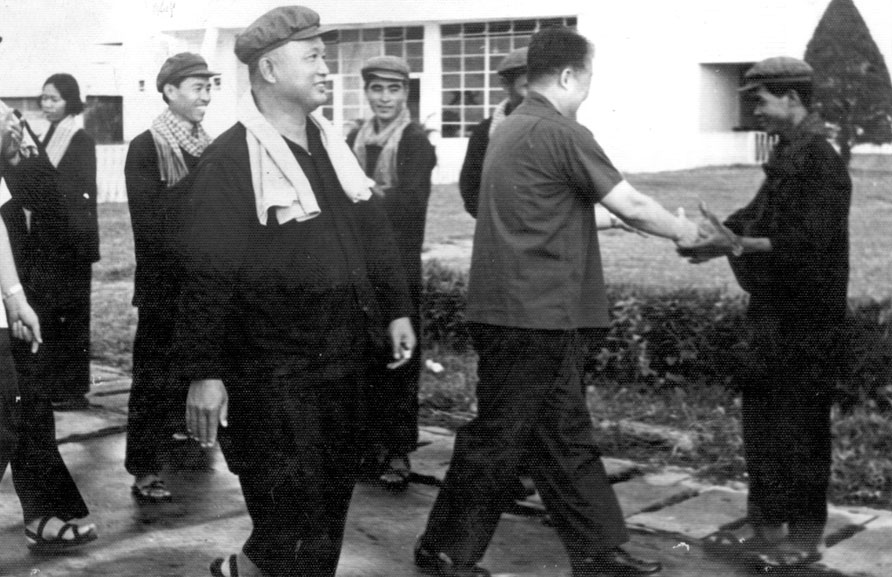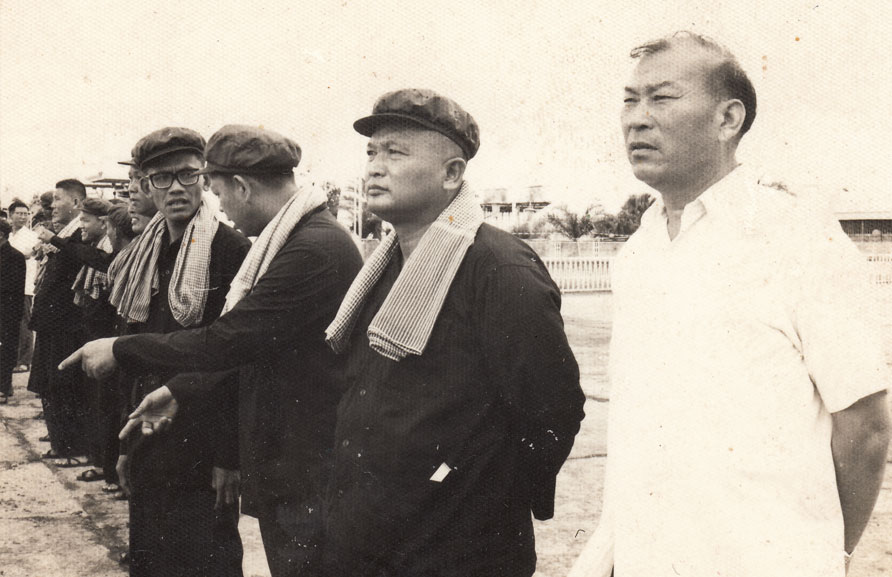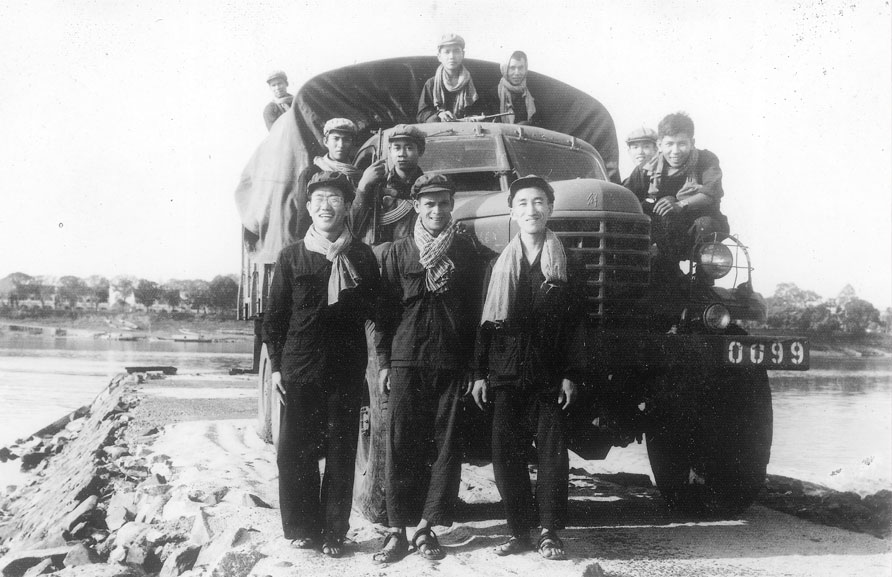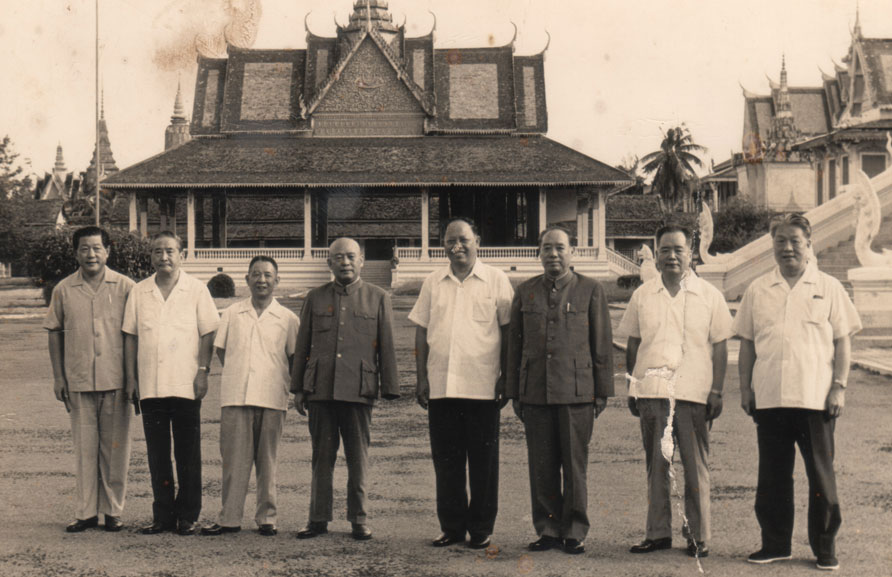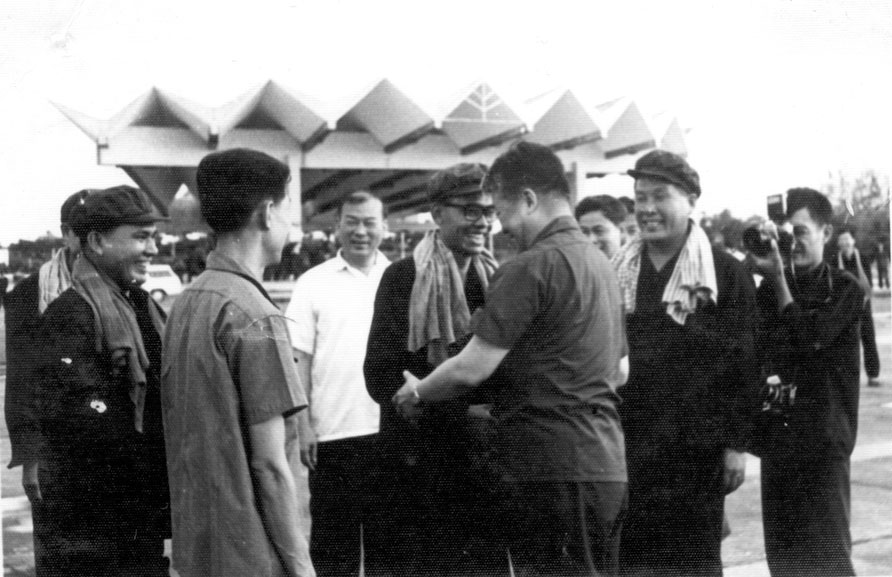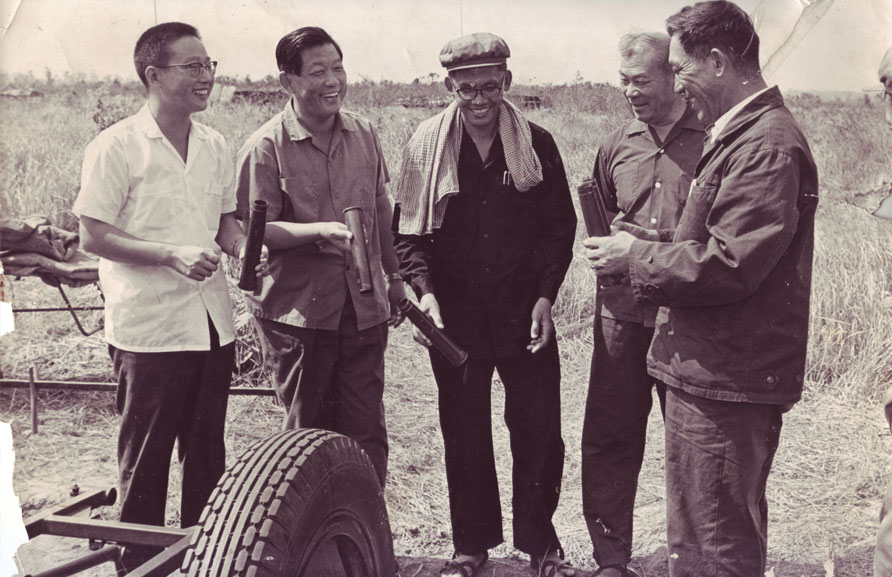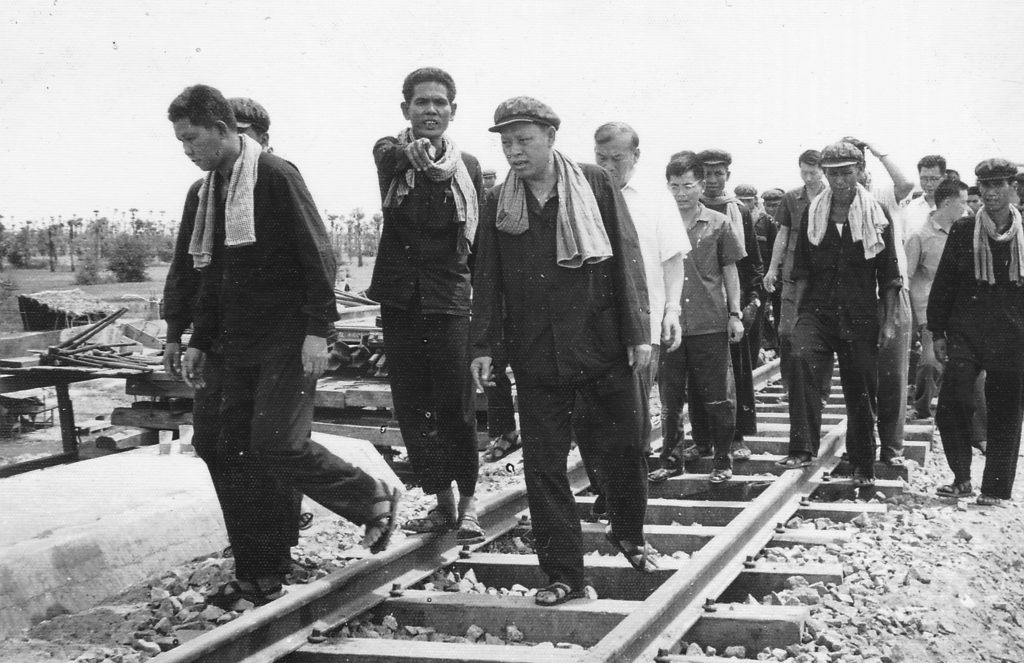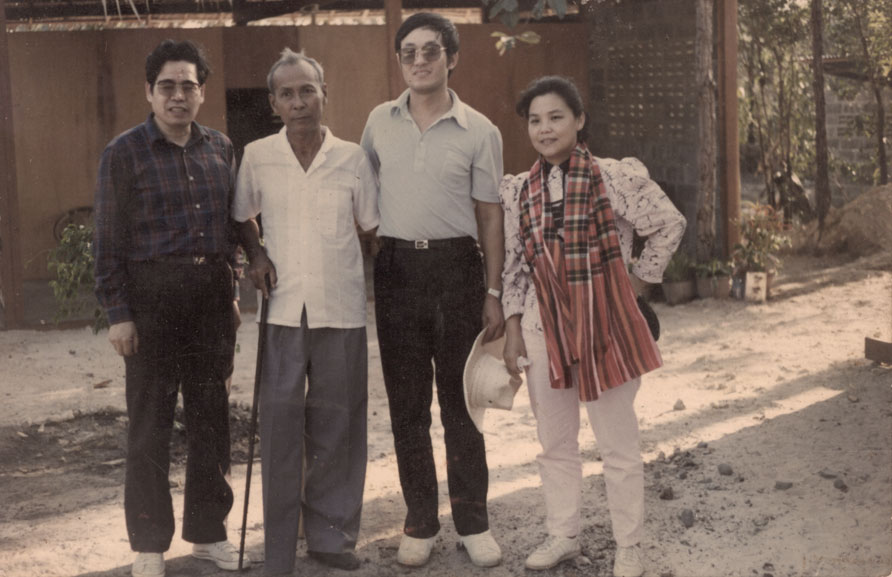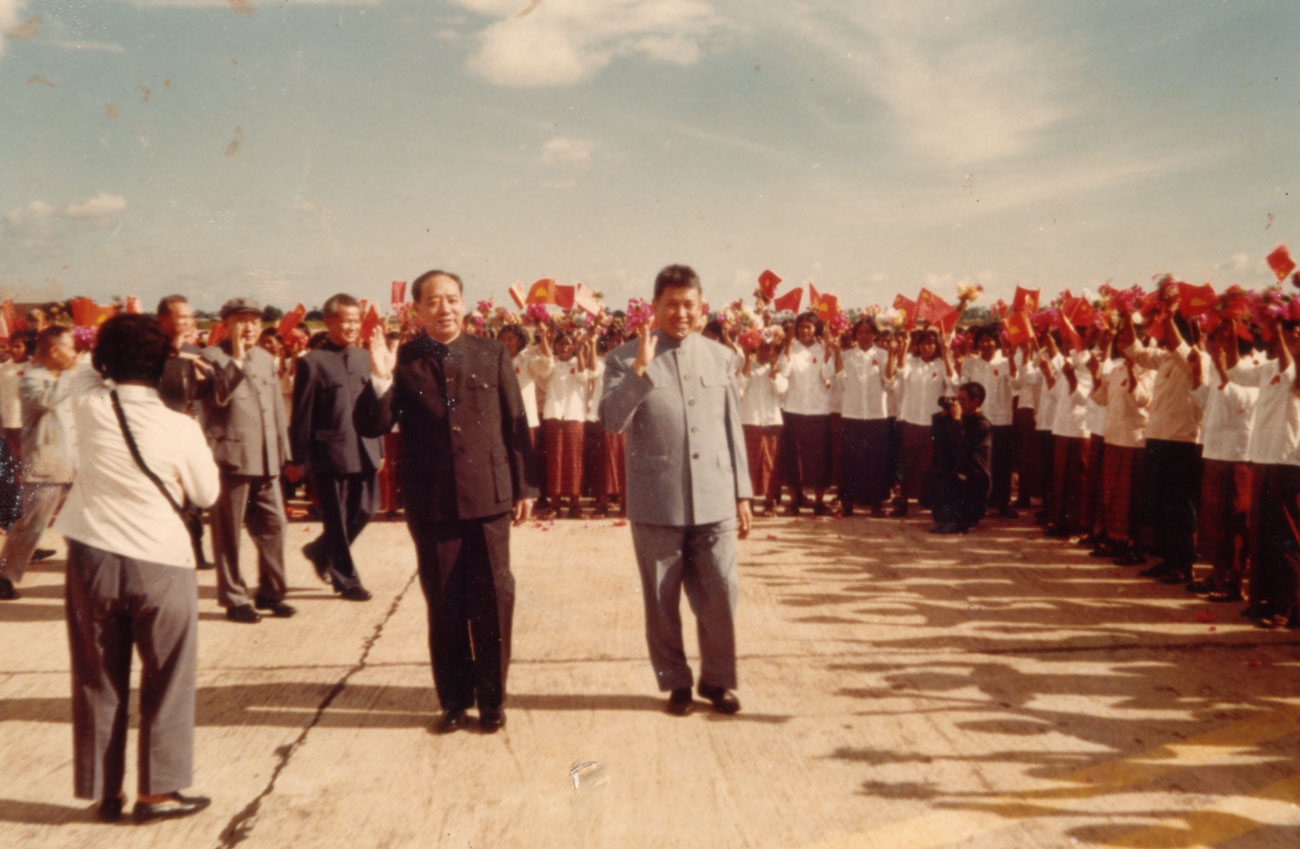Home / Development / What Did China Do In Cambodia During Democratic Kampuchea Of Pol Pot’s Time?
The Queen Mother Library is pleased to release the book, NORODOM SIHANOUK & ZHOU ENLAI: An Extraordinary Friendship on the Fringes of the Cold War, authored by Ambassador Julio A. Jeldres, Ph.D., a former Senior Private Secretary and Official Biographer to His Late Majesty the King Father Norodom Sihanouk.
The book describes the unique relationship between two statesmen of opposite backgrounds—one was a King of Cambodia, the other a Communist leader of China.
This extraordinary relationship between the monarch of an ancient Kingdom and the premier of Asia’s prominent Communist state continues to benefit their respective countries even today.
Ambassador Jeldres first became interested in this extraordinary friendship in 1970, when he was still attending college in his home country, Chile (South America).
Ambassador Jeldres recalls his distress in March 1970, after King Sihanouk had been ousted in a coup by General Lon Nol. He had great sympathy for the King’s efforts to protect the territorial integrity and independence of Cambodia.
Since 1967, Ambassador Jeldres had kept a private correspondence with King Sihanouk, and he wanted to know how the King was doing and feeling after such distressing events in Phnom Penh.
“This led me to one aspect of Sihanouk’s political life that I found especially intriguing: his association with Chinese premier Zhou Enlai. This relationship seemed to be a very special one between the head of state of a Buddhist kingdom and the prime minister of a Communist state. As a novice in international affairs, I knew little about how relationships operated between states, yet it still seemed strange to me that a ruler who claimed descendancy from the kings of Angkor had a unique relationship with the political leader of a country ideologically opposed to monarchical rule.”
Ambassador Jeldres discovered that the local New China News Agency (Xinhua) branch in Santiago, Chile, carried copies in Spanish of all of Sihanouk’s statements made in the Chinese capital a day earlier. Recalling his thinking at the time, “It didn’t seem to make sense that a Communist regime would extend such courtesies to a former monarch, particularly during the Cultural Revolution. But it was just like that. Friendship won over Ideology.”
The research for this book began in 1970 and it was completed around 2015. After 2015, Ambassador Jeldres continued to make corrections and refinements up until 2020, when the writing was finally complete.
The book contains 220 pages of first-hand accounts, information and analysis on this extraordinary relationship.
The book is published by the Documentation Center of Cambodia under its Chinese Research Project, which is funded by the United States Agency for International Development (USAID).
រូបថតជាក្រុមរបស់កងសន្តិសុខខ្មែរក្រហម និងសមមិត្តចិន ក្នុងឆ្នាំ១៩៧៧។
ប្រភព៖ បណ្ណសារមជ្ឈមណ្ឌលឯកសារកម្ពុជា។
Group photo of Khmer Rouge Security Guards and Chinese Comrades, circa. 1977.
Source: Documentation Center of Cambodia Archives
红色高棉保安员与中国同志合影,大约于1977年。
来源:柬埔寨文献中心的档案
(ពីឆ្វេងទៅស្តាំ) អ្នកបន្តវេនពី សិន ជាន, សមមិត្ត ឈិន កើតនៅក្នុងខេត្តកំពង់ចាមនិងបានទៅសិក្សានៅប្រទេសចិន, ឧត្តមសេនីយ៍ តឹង ឃុនសាន ប្រធានក្រុមអ្នកជំនាញការចិនប្រចាំរបបកម្ពុជាប្រជាធិបតេយ្យ ប៉ុល ពត។ (នៅរង្វង់ឆ្នាំ១៩៧៥)។
ប្រភព៖ បណ្ណសារមជ្ឈមណ្ឌលឯកសារកម្ពុជា។
(From left to right) Geng Biao (Successor of Shen Jian); Comrade Chhen, born in Kampong Cham and went to China; and, General Deng Kun San, Head of Chinese Experts to Democratic Kampuchea of Pol Pot. (Circa. 1975)
Source: Documentation Center of Cambodia Archives
(从左至右)耿飚(申建的继承者);同志[陈]出生于磅湛省又曾赴中国;Deng Kun San将军,担任在波尔布特的民主柬埔寨时代的中国专家领导人。(大约于1975年)
来源:柬埔寨文献中心的档案
មេដឹកនាំជាន់ខ្ពស់នៃរបបកម្ពុជាប្រជាធិបតេយ្យរបស់ ប៉ុល ពត កំពុងរង់ចាំការមកដល់របស់គណៈប្រតិភូចិន នៅឯអាកាសយានដ្ឋានពោធិ៍ចិនតុង ទីក្រុងភ្នំពេញ ក្នុងឆ្នាំ១៩៧៨។ មេដឹកនាំជាន់ខ្ពស់ខ្មែរក្រហម រាប់ពីស្តាំទៅឆ្វេង៖ អៀង ធីរិទ្ធ រដ្ឋមន្ត្រីក្រសួងសង្គមកិច្ច, យុន យ៉ាត រដ្ឋមន្ត្រីអប់រំនិងវប្បធម៌, ប៉ុល ពត នាយករដ្ឋមន្ត្រីនិងជាលេខាបក្សកម្មុយនីស្តកម្ពុជា, អៀង សារី រដ្ឋមន្ត្រីការបរទេស, វន វ៉េត រដ្ឋមន្ត្រីសេដ្ឋកិច្ច, នួន ជា ប្រធានសភាតំណាងប្រជាជន, ខៀវ ប៉ុណ្ណារី អតីតភរិយារបស់ប៉ុល ពត, (មិនស្គាល់អត្តសញ្ញាណ), និង ស៊ុន ហាវ អគ្គរដ្ឋទូតចិនប្រចាំនៅរបបកម្ពុជាប្រជាធិបតេយ្យរបស់ប៉ុល ពត។
ប្រភព៖ បណ្ណសារមជ្ឈមណ្ឌលឯកសារកម្ពុជា។
Senior leaders of Democratic Kampuchea (DK) of Pol Pot waiting for the arrival of the Chinese delegation at the Po-chen-tong International Airport, Phnom Penh (circa. 1978). DK senior leaders from right to left: Ieng Thirith, Minister of Social Affairs; Yun Yat, Minister of Education and Culture; Pol Pot, Prime Minister and Secretary of Communist Party of Kampuchea (CPK); Ieng Sary, Minister of Foreign Affairs; Vorn Vet, Minister of Economics; Nuon Chea, President of People’s Assembly; Khieu Ponnary, Pol Pot former wife; (unidentified); and, Sun Hao, Chinese Ambassador to DK of Pol Pot.
Source: Documentation Center of Cambodia Archives.
民主柬埔寨的高级领导人等待中国代表团抵达金边国际机场(波成东机场)大约于1978年。从右侧到左侧的民主柬埔寨高级主管:英蒂莉,社会事务部长;云亚,教育和文化部部长;波尔布特,主席及柬埔寨共产党总书记;英萨利,外交部长;温威,经济部长;农谢,人民议会议长; 乔波那列,波尔布特前任妻子; (身份不明); 孙浩,中国驻柬埔寨大使。
来源:柬埔寨文献中心的档案
(នៅខាងឆ្វេងបង្អស់) នី កន ប្រធានតំបន់៣២នៃភូមិភាគបស្ចិម, (កណ្តាល ជួរខាងមុខ) នួន ជា ប្រធានសភាតំណាងប្រជាជន, (ខាងស្តាំ ជួរខាងមុខ) សិន ជា អនុប្រធានការិយាល័យទំនាក់ទំនងអន្តរជាតិរបស់គណៈកម្មាការមជ្ឈិមនៃបក្សកុម្មុយនីស្តចិន។ (នៅចន្លោះឆ្នាំ១៩៧៥-១៩៧៨)។
ប្រភព៖ បណ្ណសារមជ្ឈមណ្ឌលឯកសារកម្ពុជា។
(Far left) Ni Kân, member of the 32-region committee of the West Zone; (Middle, front) Nuon Chea, President of People’s Assembly; (Right, front) Shen Jian, Deputy Chief of the International Liaison Department of the Chinese Communist Party. (Circa. 1975-1978)
Source: Documentation Center of Cambodia Archives
(最左)[尼竿], 32区西部委员会;(中间,前方)农谢,人民议会议长;(右,前方)申建,中国共产党中联部副部长。(在于1975-1978年之间)
来源:柬埔寨文献中心的档案
ទីមួយពីខាងស្តាំ ពាក់អាវពណ៌ស៖ ឧត្តមសេនីយ៍ តឹង ឃុនសាន ប្រធានក្រុមអ្នកជំនាញការចិនប្រចាំរបបកម្ពុជាប្រជាធិបតេយ្យ ប៉ុល ពត (ឧត្តមសេនីយ៍រូបនេះបានស្លាប់ដោយសារជំងឺគ្រុនចាញ់នៅប្រទេសកម្ពុជា នៅចុងឆ្នាំ១៩៧៥។
ទីពីរពីខាងស្តាំ៖ នួន ជា ប្រធានសភាតំណាងប្រជាជន និងជាអនុលេខាបក្សកុម្មុយនីស្តកម្ពុជា
ទីបីពីខាងស្តាំ៖ អៀង សារី ឧបនាយករដ្ឋមន្ត្រី និងជារដ្ឋមន្ត្រីការបរទេស
ទីបួនពីខាងស្តាំ៖ សុន សេន ឧបនាយករដ្ឋមន្ត្រី និងជារដ្ឋមន្ត្រីការពារជាតិ
អ្នកនៅចុងបង្អស់នៃជួរ៖ វន វ៉េត ឧបនាយករដ្ឋមន្ត្រី និងជារដ្ឋមន្ត្រីសេដ្ឋកិច្ច
(នៅរង្វង់ឆ្នាំ១៩៧៥)
ប្រភព៖ បណ្ណសារមជ្ឈមណ្ឌលឯកសារកម្ពុជា។
First from right, wearing white shirt: General Deng Kun San, Head of Chinese experts to Cambodia during Democratic Kampuchea of Pol Pot (The General died of malaria in Cambodia in late 1975)
Second from right: Nuon Chea, President of People’s Representative Assembly and Deputy Secretary of Communist Party of Kampuchea
Third from right: Ieng Sary, Deputy Prime Minister and Minister of Foreign Affairs
Fourth from right: Son Sen, Deputy Prime Minister and Minister of National Defense
Furthest person in the line: Vorn Veth, Deputy Prime Minister and Minister of Economy
(Circa. 1975)
Source: Documentation Center of Cambodia Archives
第一从右,穿着白色衬衫:Deng Kun San 将军担任在波尔布特时代的民主柬埔寨时代的中国专家领导人(本将军因疟疾而于1975年末逝世)
第二从右:农谢,人民代表大会主席和柬埔寨共产党副书记
第三从右:英萨利,副主席及外交部长
第四从右:宋成,副主席及国防部长
队伍中最终人物:温威,副主席及经济部长
(大约于1975年)
来源:柬埔寨文献中心的档案
រូបថតជាក្រុមរបស់កងសន្តិសុខខ្មែរក្រហម និងសមមិត្តចិន ក្នុងឆ្នាំ១៩៧៧។
ប្រភព៖ បណ្ណសារមជ្ឈមណ្ឌលឯកសារកម្ពុជា។
Group photo of Khmer Rouge Security Guards and Chinese Comrades, circa. 1977.
Source: Documentation Center of Cambodia Archives
红色高棉保安员与中国同志合影,大约于1977年。
来源:柬埔寨文献中心的档案
(ពីឆ្វេងទៅស្តាំ) ស៊ុន ហាវ អគ្គរដ្ឋទូតចិនប្រចាំរបបកម្ពុជាប្រជាធិបតេយ្យ ប៉ុល ពត, ហាន នានឡុង អនុប្រធាននាយកដ្ឋានការបរទេសប្រទេសចិន, ហ៊ូ យ៉ាវប៉ាង អគ្គលេខាបក្សកម្មុយនីស្តចិន, (មិនស្គាល់អត្តសញ្ញាណ), អៀង សារី ឧបនាយករដ្ឋមន្ត្រីនិងជារដ្ឋមន្ត្រីការបរទេស, វ៉ាង តុងស៊ីង អនុលេខាបក្សកុម្មុយនីស្តកម្ពុជា, (មិនស្គាល់អត្តសញ្ញាណ), សិន ជាន អនុប្រធានការិយាល័យទំនាក់ទំនងអន្តរជាតិរបស់គណៈកម្មាការមជ្ឈិមនៃបក្សកុម្មុយនីស្តចិន។ (នៅចន្លោះឆ្នាំ១៩៧៥-១៩៧៨)
ប្រភព៖ បណ្ណសារមជ្ឈមណ្ឌលឯកសារកម្ពុជា។
(Left to right) Sun Hao, Chinese Ambassador to Democratic Kampuchea; Han Nian Long, Vice Foreign Minister of China; Hu Yao-Bang, Secretary General of the Communist Party of China; (unidentified); Ieng Sary, Deputy Prime Minister and Minister of Foreign Affairs; Wang Dong Xing, Vice Chairman of the Communist Party of China; (unidentified); Shen Jian, Deputy Chief of the International Liaison Department of the Communist Party of China. (Circa. 1975-1978)
Source: Documentation Center of Cambodia Archives
(从左至右)孙浩,在民主柬埔寨的中国大使;韩念龙,中国外交部副长;胡耀邦,中国共产党总书记;(身份不明);英萨利,副主席及外交部长;汪东兴,中国共产党副书记;(身份不明);申建,中国共产党中联部副部长。(在于1975-1978年之间)
来源:柬埔寨文献中心的档案
(ពីឆ្វេងទៅស្តាំ) កុយ ធួន រដ្ឋមន្ត្រីពាណិជ្ជកម្មនៃរបបកម្ពុជាប្រជាធិបតេយ្យ ប៉ុល ពត, ឧត្តមសេនីយ៍ តឹង ឃុនសាន (ពាក់អាវពណ៌ស) ប្រធានក្រុមអ្នកជំនាញការចិនប្រចាំរបបកម្ពុជាប្រជាធិបតេយ្យ ប៉ុល ពត, សុន សេន (ពាក់វ៉ែនតា) ឧបនាយករដ្ឋមន្ត្រនិងជារដ្ឋមន្ត្រីការពារជាតិ, សិន ជាន (ចាប់ដៃជាមួយ សុន សេន) អនុប្រធានការិយាល័យទំនាក់ទំនងអន្តរជាតិរបស់គណៈកម្មាការមជ្ឈិមនៃបក្សកុម្មុយនីស្តចិន, ពេជ ប៊ុនរ៉េត កម្មាភិបាលក្រសួងការបរទេសនៃរបបកម្ពុជាប្រជាធិបតេយ្យប៉ុល ពត, និង ណៃ សារ៉ាន ហៅ យ៉ា លេខាភូមិភាគពាយ័ព្យ។ (នៅចន្លោះឆ្នាំ១៩៧៥-១៩៧៨)។
ប្រភព៖ បណ្ណសារមជ្ឈមណ្ឌលឯកសារកម្ពុជា។
(Left to right): Koy Thuon, Democratic Kampuchea of Pol Pot’s Minister of Commerce; General Deng Kun San (wearing white shirt), Head of Chinese Experts to Cambodia during DK of Pol Pot; Son Sen (wearing glasses), Deputy Prime Minister and Minister of National Defense; Shen Jian (shaking hand with Son Sen), Deputy Chief of International Liaison of Chinese Communist Party’s Central Committee; Pich Bunreth, Cadre of DK of Pol Pot’s Ministry of Foreign Affairs; and, Nay Saran alias Ya, Secretary of Northeast Zone. Others are unidentified. (Circa. 1975-1978)
Source: Documentation Center of Cambodia Archives.
(左至右)贵敦,在民主柬埔寨的贸易部长;Deng Kun San 将军(穿着白衬衫)担任在民主柬埔寨时代的中国专家领导人;宋成(戴眼镜),副主席及国防部长; 申建(跟宋成握手),中国共产党中联部副部长;[毕笨烈],民主柬埔寨外交部负责干部;奈沙朗又称亚,东北区秘书。其他人身份不明。(在于1975-1978年之间)
来源:柬埔寨文献中心的档案
(ពីឆ្វេងទៅស្តាំ) សមមិត្ត លីន (ជនជាតិចិន) អ្នកបកប្រែភាសាចិន-ខ្មែរ, ស៊ុន ហាវ អគ្គរដ្ឋទូតនៃសាធារណរដ្ឋប្រជាមានិតចិនប្រចាំនៅរបបកម្ពុជាប្រជាធិបតេយ្យ ប៉ុល ពត, សុន សេន ឧបនាយករដ្ឋមន្ត្រីនិងជារដ្ឋមន្ត្រីការពារជាតិ, ឧត្តមសេនីយ៍ តឹង ឃុនសាន ប្រធានក្រុមអ្នកជំនាញការចិនប្រចាំរបបកម្ពុជាប្រជាធិបតយ្យ ប៉ុល ពត, និង អ្នកបច្ចេកទេសចិន។ (នៅរង្វង់ឆ្នាំ១៩៧៥)។
ប្រភព៖ បណ្ណសារមជ្ឈមណ្ឌលឯកសារកម្ពុជា។
(Left to right): Comrade Lin (Chinese), Chinese-Khmer translator; Sun Hao, People’s Republic of China’s Ambassador to DK of Pol Pot; Son Sen, Deputy Prime Minister and Minister of National Defense; General Deng Kun San, Head of Chinese Experts to Cambodia during DK of Pol Po; and, Chinese technician. (Circa. 1975)
Source: Documentation Center of Cambodia Archives.
(左至右)林同志(华人),中柬翻译员;孙浩,中华人民共和国驻民主柬埔寨大使。宋成,副主席及国防部长;Deng Kun San 将军,担任在民主柬埔寨时代的中国专家领导人;中国技术人员。(大约于1975年)
来源:柬埔寨文献中心的档案
(ពីឆ្វេងទៅស្តាំ) នៅចុងឆ្នាំ១៩៧៥។ វន វ៉េត ឧបនាយករដ្ឋមន្ត្រីនិងជារដ្ឋមន្ត្រីសេដ្ឋកិច្ច, ម៉ី ប្រាង (កំពុងចង្អុល) ប្រធានក្រុមទំនាក់ទំនង, នៅខាងក្រោយ អៀង សារី គឺ ឧត្តមសេនីយ៍ តឹង ឃុនសាន (ពាក់អាវពណ៌ស) ទទួលបន្ទុកជាប្រធានអ្នកជំនាញការចិនប្រចាំនៅរបបកម្ពុជាប្រជាធិបតេយ្យរបស់ប៉ុល ពត, សមមិត្ត ស៊ូ (ឈរនៅពីក្រោយឧត្តមសេនីយ៍ព្រមទាំងពាក់វ៉ែនតា) អ្នកបកប្រែភាសា, និង តាម៉ុក លេខាភូមិភាគនិរតី។ អ្នកដទៃទៀតមិនអាចកំណត់អត្តសញ្ញាណបាន។
ប្រភព៖ បណ្ណសារមជ្ឈមណ្ឌលឯកសារកម្ពុជា។
(Left to right): In late 1975. Vorn Vet, Deputy Prime Minister and Minister of Commerce; Mei Prang (pointing finger), Chief of the Communication Committee; Ieng Sary, Deputy Prime Minister and Minister of Foreign Affairs; behind Ieng Sary (white shirt), General Deng Kun San, Head of Chinese experts to Cambodia during the DK of Pol Pot; Comrade Su (standing behind the General and wearing glasses), translator; and Ta Mok, Secretary of Southwest Zone. Others are unidentified.
Source: Documentation Center of Cambodia Archives.
(左至右)在1975年末;威温,副主席及经济部长;[魅庞](手指着),通信部长;英萨利,副主席及外交部长;英萨利的后面,Deng Kun San 将军(穿着白衬衫),担任在民主柬埔寨时代的中国专家领导人;[苏]同志(站在将军及戴眼镜),翻译员;及塔莫克,西南区书记。其他人身份不明。
来源:柬埔寨文献中心的档案
រូបថតនៅស្រុកអន្លង់វែង បន្ទាប់ពីរបបកម្ពុជាប្រជាធិបតេយ្យ ប៉ុល ពត ដួលរលំ។ (ពីឆ្វេងទៅស្តាំ) សមមិត្ត ហ៊្វូ អ្នកបកប្រែភាសាចិន-ខ្មែរ (ក្រោយមក សមមិត្តនេះ បានក្លាយទៅជាអគ្គរដ្ឋទូតប្រចាំនៅព្រះរាជាណាចក្រថៃ, តាម៉ុក លេខាភូមិភាគនិរតី, កម្មាភិបាលនៃក្រសួងការបរទេសប្រទេសចិន, និង សមមិត្ត ចាង ដែលក្រោយមក បានក្លាយទៅជាអគ្គរដ្ឋទូតប្រចាំនៅព្រះរាជាណាចក្រកម្ពុជា។
ប្រភព៖ បណ្ណសារមជ្ឈមណ្ឌលឯកសារកម្ពុជា។
The photo was taken in Anlong Veng District after the fall of the DK of Pol Pot.(Left to right): Comrade Fu, Chinese-Khmer translator and, later serving as Chinese Ambassador to Thailand; Ta Mok, Secretary of Southwest Zone; Cadre of China’s Ministry of Foreign Affairs; and, Comrade Zhang, later serving as Chinese Ambassador to Cambodia.
Source: Documentation Center of Cambodia Archives.
在安隆文,民主柬埔寨灭绝之后所拍的照片。(左至右)傅同志,中柬翻译员、然后,他担任中国驻泰王国大使;塔莫克,西南区书记;中国外交部负责干部;张同志 – 然后,她担任中国驻柬埔寨大使。
来源:柬埔寨文献中心的档案
(Center, right): Pol Pot, Prime Minister and Secretary of Communist Party of Kampuchea (CPK) with Wang Dong Xing, Deputy Head of Chinese Communist Party’s Central Committee. (Behind Wang Dong Xing): Khieu Samphan, President of State’s Presidium of Democratic Kampuchea. (First from left): Hu Yao Bang, General Secretary of Chinese Communist Party’s Central Committee. (Second from left): Nuon Chea, President of People’s Representative Assembly and Deputy Secretary of Communist Party of Kampuchea.
On Friday 16 November, 2018, the Khmer Rouge Tribunal convicted Nuon Chea and Khieu Samphan of genocide, crimes against humanity and grave breaches of the Geneva Conventions of 1949. The crimes were committed at various locations throughout Cambodia during the Democratic Kampuchea period from 17 April 1975 to 6 January 1979. The Trial Chamber sentencing both Nuon Chea and and Khieu Samphan to life imprisonment.
Pol Pot became prime minister of Democratic Kampuchea in 1976 and resigned in 1979, but remained an active leader of the Khmer Rouge. He lived in exile, mainly in Thailand, until his death in Anlong Veng district, Oddar Meanchey province, on April 15, 1998. His body was cremated on 17 April, 1998.
Source: Documentation Center of Cambodia’s Archives
波尔布特和中国:金边·1978年11月4日
(中间,右边):波尔布特–总理及柬埔寨共产党书记与汪东兴–中国共产党中央委员会副主席。(汪东兴的后面):乔森潘–民主柬埔寨主席团元首。(左一):胡耀邦–中国共产党中央委员会总书记。(左二):农谢–人民代表大会主席及柬埔寨共产党中央委员会副书记。
在2018年11月16日星期五,红色高棉大审判判决农谢和乔森潘以种族灭绝、危害人类罪及严重违反日内瓦公约(1949)。从1975年4月17日至1979年1月6日,此罪被犯在整柬埔寨的不同地点。大审判判处农谢和乔森潘终身监禁。
波尔布特在于1976年任民主柬埔寨总理,然后在1979年辞职,却仍是一位红色高棉的积极领导人。他在外流亡,大多数在泰国,直到他过世在安隆文县,奥多棉吉省,于1998年4月15日。他的尸体被火化在1998年4月17日。
来源:柬埔寨文献中心的档案
GENOCIDE EDUCATION IN CAMBODIA: Pol Pot Visits China on 29 September 1977
GENOCIDE EDUCATION IN CAMBODIA: Democratic Kampuchea & China Relations
Report
Excerpts
Ben Kiernan has highlighted in his journal article in the “Journal of Contemporary Asia” on the different treatment the Khmer Rouge conducted on Vietnamese, Cham and Chinese ethnic during the Khmer Rouge regime. Ben stated that while Khmer Rouge ruthlessly targeted Vietnamese and Cham ethnic due to their racial identity, Chinese group were targeted because of being prejudiced and categorized as the city dweller/exploiting group. Unlike the former groups, the latter was prone to harsh labor, starvation and disease rather than the execution enforced by the Khmer Rouge. Ben also mentioned that “like many urban Khmer,” in the first evacuation on April 17, 1975 and the second forced transfers, “the Chinese” moved to their village of origin, mainly to “the Eastern and Southwest zone”; and, to “the Northwest Zone near the Thai border,” respectively. Ben also has conducted interviews with the survivors of Khmer Rouge regime and found out that: Chinese ethnic were kept in a village called “the Chinese village,” while the village chief was a Chinese “new person.” At the Eastern zone, Chinese ethnic were not targeted as the base people in this zone during the purge. “Chinese ethnic was not oppressed just because they were Chinese.” Ben concluded that “It may be true as a general statement to say that despite prohibition of their language and cultural autonomy, ethnic Chinese would have been safe enough in Democratic Kampuchea if they could satisfy their Khmer Rouge rulers that they were of poor social origins.”
The paper narrated that Khmer Rouge started as Khmer Issarak and received support, particularly, a massive support from Thai Government in Bangkok in 1946, and how Khmer Issarak evolved after the major aid cutoff following the Thai rightist coup in November 1947. This has caused the fractures among the Issarak, resulted in some members joined with Sihanouk to fight for “real independence” while the other received support from North Vietnam to continue their “Revolutionary Organization”. The latter group later isolated themselves from the Vietnam side, and emerged as “Democratic Kampuchea”. The group’s representative, Khieu Samphan, set in a major visits to the Asian Communist World, part of Eastern Europe and Africa in February 1974; and, during his Peking visit, he and his companion, Ieng Sary, were formally welcomed by the Chinese top leaders, Keng Piao – Director of the International Liaison Department of the Central Committee of the Communist Party of China, and his Deputy, Sen Chien, evidenced “a strong Chinese desire to give his international face.” The paper mainly cited the information provided by Ith Sarin, author of “Sranoh Proloeng Khmer,” who fled Cambodian, as well as the thesis by the Khmer Rouge leaders, Khieu Samphan and Hu Nim as well as the China’s news reporting.
The paper analyzed how China’s foreign policy created its role and powers in its weak alliance states. It suggested that Cambodia is one among the sixteen vulnerable stated, affected by the China’s “Debt Book Policy.” The paper also highlighted the three main objectives of China’s provision of foreign aids, including “reaping friendly relations and friendly economic cooperation with developing countries, enhancing South-Sourth cooperation, and contributing to development.” However, in actual practice, China has utilized its aid as a too to project its power and influence into the aid recipient countries, suggested by the many scholars.
The paper also looked into the influences of China in Cambodia, with the particular retrospective details on Chinese involvement during the Khmer Rouge era. The details, the paper suggested, were the deployment of Chinese advisors to DK and the close relations between DK and China. The paper quoted the statement of DK leaders, namely Pol Pot and Ieng Sary, praising China and treating China as the DK’s friend and brother. The study also suggested that despite the policy of neutral and independent stance without the foreign interference on DK, Pol Pot’s implementation of the policy was contrasted, and Pol Pot “stipulated the foreign policies that ran what China wanted”; DK and China had a joint communique on economic and trade development on August 1975, proclaiming the determination to unite, support each other and advance together in the common struggle against colonialism, imperialism and hegemonism and committed for the realization of full independence, sovereignty and economic development.
The paper concluded that China aided DK since it aimed to obtain at least four main favors from Pol Pot: “1) foreign policies to oppose all forms of imperialism, aggression, expansionism, intervention, and hegemonism; 2) recognition and massive support for China’s concept of the three worlds; 3) the decision to distance Cambodia from Vietnam; and, 4) permission to allow thousands of Chinese advisers and technical assistants to work in the country.” China also aimed at three benefits through the provision of massive aid to Pol Pot; they were: to get Pol Pot on its side, to mitigate the dire security threat from USSR’s encirclement policy, and to grasp the chance for influence in the Indochina peninsula by using Cambodia as its foundation. China also granted gigantic military support to Pol Pot to keep him in power to let him serve China’s strategic interest longer.
To show its supports for the battling struggle Khmer Rouge had been being through, China sent it news agency delegates to the liberated zone to witness the Khmer Rouge effort and publicize it to the Chinese audiences in March 1975. The delegation visited a number of areas, including well-known National Road 6 battleground at the northern part of Baray; Toap (Army) village in Stung Trang district and Koh Soten district, Kampong Cham province; weapon repairing factory in Kampot province; Angkor Borey district, Kampot province; Phnom Penh Frontline Battleground; Neak Loeung area; Baseth Mountain; Peam Riang Island and Mesang district in Prey Veng province; Angkor Wat Temple and Kulen Mountain in Siem Reap province; as well as Dam and other areas along Mekong River.
The delegation was warmly welcomed and guided by Khmer Rouge top ranking, namely Son Sen, Chou Chet and some other local commanders during the visit. They were shown around the temple compound in Siem Reap province, where Khmer Rouge used as its bases to fight against American-backed Lon Nol forces. The delegates had eye-witnessed the fighting tactics Khmer Rouge deployed during the battle in Peam Riang Island, where Khmer Rouge surrounded the opponents and confiscated a number of weapons and ammunitions, defeating and capturing the enemies eventually. The delegation described the Khmer Rouge struggle in a praising tone and shown emotionally supports to the Khmer Rouge forces. After the short visit, the delegation left Cambodia in April 1975, and several days later, they received the news that Khmer Rouge got the victory over their enemies and captured the country entirely.
Ben Kiernan has highlighted in his journal article in the “Journal of Contemporary Asia” on the different treatment the Khmer Rouge conducted on Vietnamese, Cham and Chinese ethnic during the Khmer Rouge regime. Ben stated that while Khmer Rouge ruthlessly targeted Vietnamese and Cham ethnic due to their racial identity, Chinese group were targeted because of being prejudiced and categorized as the city dweller/exploiting group. Unlike the former groups, the latter was prone to harsh labor, starvation and disease rather than the execution enforced by the Khmer Rouge. Ben also mentioned that “like many urban Khmer,” in the first evacuation on April 17, 1975 and the second forced transfers, “the Chinese” moved to their village of origin, mainly to “the Eastern and Southwest zone”; and, to “the Northwest Zone near the Thai border,” respectively. Ben also has conducted interviews with the survivors of Khmer Rouge regime and found out that: Chinese ethnic were kept in a village called “the Chinese village,” while the village chief was a Chinese “new person.” At the Eastern zone, Chinese ethnic were not targeted as the base people in this zone during the purge. “Chinese ethnic was not oppressed just because they were Chinese.” Ben concluded that “It may be true as a general statement to say that despite prohibition of their language and cultural autonomy, ethnic Chinese would have been safe enough in Democratic Kampuchea if they could satisfy their Khmer Rouge rulers that they were of poor social origins.”
